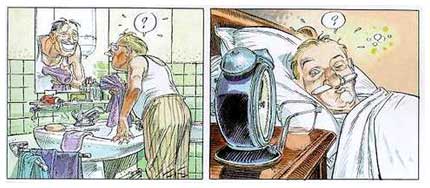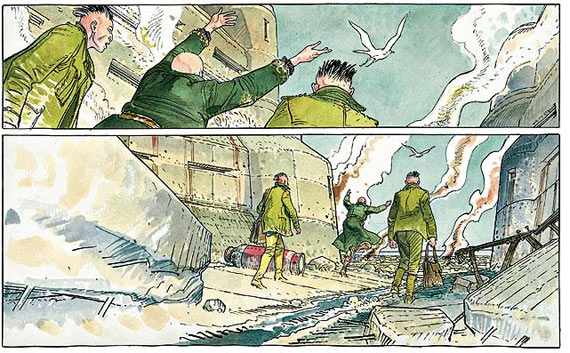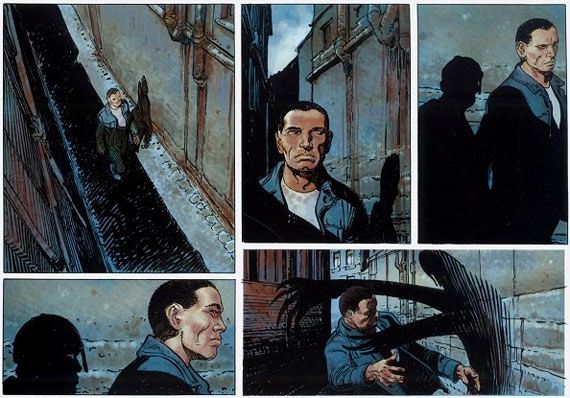'Bouncer'. Dutch-language version.
Lille-born comic artist François Boucq began his career in 1974 as a political caricaturist for Le Point, L'Expansion, Play-Boy and Le Matin de Paris. He published his first comics in Mormoil in the following year, while also making sculptures for the Lille carnival. He left his career in arts for a couple of years, until he began a collaboration with Pilote in 1978. He created a series of short stories under the title 'Cornets d'Humour' with scriptwriter Philippe Delan, later reprinted in album format under the title 'La Vie, la Mort et Tout le Bazar'.
'Rock Mastard'.
Boucq became a regular in Fluide Glacial in 1980, for which he created 'Les Leçons du Professeur Bourremou' with Pierre Christin and the adventures of 'Rock Mastard' with Delan in a style influenced by Alexis. He turned to more experimental artwork and narratives when he started writing and drawing stories for (A Suivre) in 1983. His stories for his magazines were later collected in the books 'Les Pionniers de l'Aventure Humaine', 'Point de Fuite pour les Braves', 'La Pédagogie du Trottoir' and 'La Désiroire Effervescence des Comprimés'. One of the characters from these books was leopardskin-wearing insurance agent 'Jérôme Moucherot', who starred in his own series of albums by Casterman since 1993.
'Jérôme Moucherot'.
A meeting with the American writer Jerome Charyn in 1984 resulted in the books 'La Femme du Magicien' (Casterman, 1986) and 'Bouche du Diable' (Casterman, 1990). He also illustrated Charyn's travelogue 'Du Ventre de la Bête - New York' in 1994. In 1991, he cooperated with Alejandro Jodorowsky for the first time, when the first installment in their fantasy fiction 'Face de Lune' was published by Casterman. The second book followed in 1997, the third in 2004.
'Face de Lune'.
By the early 1990s, Boucq began expanding his activities outside the field of comics. He made drawings for the Antenne 2 TV show 'Si Ça Vous Change', on-the-spot drawings at the Cannes festival, illustrations for the magazines Corto, Science and Vie Junior, and the drawings for Jodorowsky's fable book 'Le Trésor de l'Ombre'. He also adapted one of his short stories to a film, 'Mea Culpa', shown at the 1998 Angoulême festival. He embarked on a new series of short stories for (A Suivre) and Fluide Glacial in 1995, all starring the Grim Reaper and his pig friend, collected in the book series 'Les Aventures de la Mort et de Lao-Tseu'.
'Les Aventures de la Mort et de Lao-Tseu' (Fluide Glacial Hors Série #28).
In 1983, François Boucq was one of many comic artists paying homage to the recently deceased Hergé in a special issue of (À Suivre), titled 'Adieu Hergé'. He paid tribute to Nikita Mandryka in the collective comic book 'Tronches de Concombre' (Dupuis, 1995). Together with 20 other comic artists (Zep, Ptiluc, Frank Margerin, Yslaire, Cosey, Philippe Vuillemin, Milo Manara, Loustal, Gilbert Shelton, Max Cabanes, Dupuy & Berberian, Gérald Poussin, Thomas Ott, Frank Pé, Frank Le Gall, Riff Reb's, Eric Buche, Enrico Marini and Valott) he illustrated a record single for the project '20 Vraies Fausses Pochettes De Disque Par 20 Vrais Dessinateurs de BD' (1995). Boucq chose for a song by Charles Trenet.
'Le Janitor'.
One of Boucq's best known works is the hardboiled western series 'Bouncer', which he started with Jodorowsky in 2001. He is also working with Yves Sente on the series 'Le Janitor', published by Dargaud since 2007. He drew the fourth installment in the series 'XIII Mystery' about Colonel Amos in 2011 (script by Alcante). Boucq has participated in a great many collective comics projects, including 'La Bande à Renaud', 'Les Pires Noëls', 'Le Violon et l'Archer', 'La Bibliothèque fantastique', 'Sales Petits Contes' and 'Paroles de Verdun', as well as a series of reflective books about comics for Éditions On a marché sur la bulle in 2006.
François Boucq was an influence on Stefano Carloni and Stedho.
Poster for the 2nd International Salon of the Comic Strip, organized in Kortrijk/Courtrai, Belgium on 13-14-15 May 1989, during the annual Sinksenfeesten Festival. Walt Disney's towering Mickey Mouse pushes down several European comic characters. We recognize in the left corner top to down: E.P. Jacobs’ Blake & Mortimer, Dupa's Cubitus, Jacques Tardi's Adèle Blanc-Sec, André Franquin's Fantasio and Spirou (whose legs stick out behind Adèle's head), Jean Giraud’s Jimmy McClure (from 'Blueberry’), Jean Roba’s Bill, Peyo’s Smurf, Willy Vandersteen’s Lambik, Gotlib’s Professeur Burp (from 'Rubrique-à-Brac’), Hergé's Tintin, Albert Uderzo’s Obelix, Morris’ Jolly Jumper, Victor Hubinon’s Barbe-Rouge, Hugo Pratt’s Corto Maltese, Willy Linthout’s Urbanus, Jean-Claude Mézières' Shingouz (from 'Valérian et Laureline') and Albert Uderzo’s Tanguy (from 'Tanguy & Laverdure'). In the right corner we notice André Franquin’s Marsupilami, with Spip the squirrel (from 'Spirou') hanging on the tip of his tail in the left upper corner. Beneath the Marsupilami's legs Jean-Claude Mézières’ Laureline and a grognon from Bluxte (both from 'Valérian et Laureline’) can be spotted. High in the air we see the pterodactyl from Jean Giraud’s 'Arzach'.








